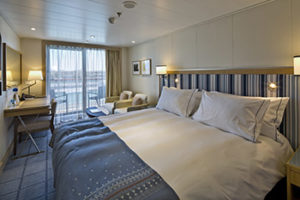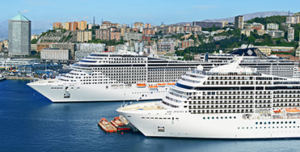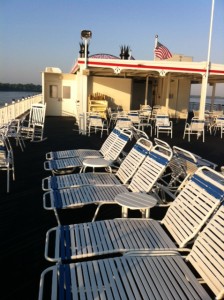
The Deluxe Veranda staterooms on Viking Ocean ships are terrific, if you can afford them. Photo from Viking Cruises.
Note: This is the first in a series of posts about how to get the best value for your cruise dollar.
Which cabin you choose can mean a difference of hundreds or even thousands of dollars in your cruise fare. Along with the general luxury level of the cruise line itself, the length of your cruise — and your ability to restrain yourself at the casino, bar, or art auction — your cabin category is likely to be the main variable in the entire cost of your cruise.
How do most cruise lines price their cabins and suites? Three general rules usually come into play:
- The higher the deck, the higher the price of the cabin.
- The bigger the room, the higher the price.
- The better the water view, the higher the price. If you include a veranda, or balcony, the price goes up even more.
The big money question
While all these factors may be generally desirable, are they really worth the additional cash? Some answers may surprise you.
Begin by asking yourself, “How much time do I expect to spend in my cabin?”
Imagine yourself…
To help you judge, form some mental images of yourself on a cruise ship.
First, picture yourself inside your cabin, perhaps watching movies or sitting by your window or on your private veranda and ordering room service as you watch the ocean go by. If that’s your ideal of a cruise, you may want to shell out for a premium cabin.
Alternatively, picture yourself enjoying the sunshine and sea breezes on deck, having a drink in the lounge, eating breakfast in the dining room, participating in some of the organized shipboard activities, and watching the evening shows in the ship’s theater.
If the second image appeals to you, you’re a good candidate for one of the less expensive cabins.

Tropical weather in the Caribbean may influence your choice of cabin. Photo courtesy of Sandals
In short, the more time you expect to spend in your cabin, the more sense it makes to pay more for it. But if you use your cabin mostly for sleeping and changing clothes, why not save yourself potentially tons of cash?
Smooth Sailing Tip:
When deciding how much time you’re likely to spend in your cabin, take into account the typical weather where you’ll be cruising.
If you’re headed to Caribbean warmth, you’ll probably spend less time inside and more time on deck and at the pool. If you’re cruising in cool or cold weather, or where it may be likely to rain a fair amount, you may spend more time inside and want to opt for a higher-priced cabin with a window. (Verandas are the wild cards in the weather equation — they make more sense in warm than cold weather, but, paradoxically, may be superfluous if you’re up on deck a lot.)
Smooth Sailing Tip #2:
If your cruise includes a lot of port stops, with a good deal of time in each port, you’re also likely to spend less time in your cabin.
If your cruise includes several days at sea, you may well spend more time in your cabin, perhaps justifying spending more on your accommodations.
Higher…and higher
Now let’s take a look at the first rule of how most fares are fixed: the higher the deck, the higher the price of the cabin (at least compared to cabins of similar size and amenities on lower decks).
Why are higher-deck cabins considered preferable?
The convenience factor

Higher decks usually mean higher prices. Photo from MSC Cruises
One reason is convenience. On most ships, the higher decks are closer to the main public areas, such as the sun deck with swimming pools and al fresco eating areas. Sometimes they’re nearer to the main dining rooms, though not always.
But remember: most big cruise ships have elevators. So if you can walk to an elevator, getting to the public spaces is usually only a matter of a few seconds riding time.
And all cruise ships have staircases. So yes, you’ll sometimes have to climb more stairs if you’re on a lower deck — but consider it a good opportunity to get some exercise (perhaps in penance for stuffing yourself at the buffet).
The window factor
A second reason why higher decks are considered preferable is related to the water view rule: cabin windows tend to be bigger on higher decks than those on lower decks. And lower deck cabins are more likely to have obstructed views as well.
But you can’t always count on this formula: when booking your cruise, never assume that any given cabin has a great view just because of its general location on the ship.
Smooth Sailing Tip:
Be sure to ask your booking agent if the cabin you have in mind has an obstructed view before putting your money down.
The noise factor
A third reason why higher decks are considered preferable is that higher-deck cabins are often noisier than lower-deck cabins, which may get more engine rumblings (especially those located near the stern, or rear, of the ship) or more anchor noise (especially those located near the bow, or front, of the ship).
But you can’t always count on a higher-deck cabin being less noisy. For instance, it may have a busy hallway in front of it, or it may be located directly above or below a noisy dance floor or jogging track.
In fact, since higher-deck cabins tend to be nearer public spaces on the ship, they are also more likely to get noise from them.
Smooth sailing tip:
Higher cabins also have another potential disadvantage: you’re more likely to feel motion sickness on a higher than lower deck, due to the rolling motion of the ship. (This is especially true on smaller ships.)
So if you’re prone to queasiness, you may find that you’ve paid more for a cabin that only makes your problem worse.
Size matters….or does it?
We now come to the second major factor in cabin price: its size.
While roominess is always nice, keep in mind that on many modern cruise ships, even the smallest standard cabins typically offer enough space for a queen-sized bed, a writing desk, some end tables, two closets, a bathroom, and often a small sofa. The more luxurious the ship, the bigger the standard cabins tend to be.
Some cruise ships are also changing the definition of “suite” from two or more rooms to one room with a dividing point of sorts. If you shell out big bucks for a suite, make sure you’re getting a real one.
How about verandas?
Keep in mind that just because you may shell out thousands of dollars extra for a veranda doesn’t guarantee you’ll get a large veranda. Some are barely spacious enough to crowd in a couple of chairs and a small table.

A deck chair offers plenty of water views without need of a private veranda. Photo by Clark Norton
Other verandas may lack privacy, open to public gaze either from your neighbors’ balconies or from decks above.
Some may be windy or noisy, depending on their placement on the ship — or your neighbors’ boisterousness.
If your veranda turns out to be less than idyllic — either because of bad weather or bad luck — you may find yourself not using it all that much, even if you paid a small fortune for it.
We’ve already touched on the third main factor that often results in higher cabin prices: the quality of the water view.
Water Views
For this reason, the least expensive cabins are almost always inside cabins with no water view whatsoever.
But think about this: you can get all the water views you want by leaving your room, going out on deck or sitting in a lounge with panoramic windows, and gazing at the sea for hours.
Believe me, no one will stop you. When you’re in a public area of a cruise ship, all passengers are created equal: those who paid $1,000 for an inside cabin are just as entitled to the views as those who paid $10,000 for the fanciest veranda suite.
I’m not knocking veranda suites — they’re great if you can afford them. If you want to pay three or four times as much for one as for an inside cabin, that’s entirely your prerogative.
But if you are on a budget, there are excellent value options — and you can have just as good a cruise as the big spenders on the higher decks.
Smooth Sailing Tip:
If you have a window in your cabin, ask your booking agent if it looks directly out to sea or onto a deck — and, if the latter, whether passengers strolling along can see directly into your space.
If you have to close your curtain to get privacy, that could negate the value of a window altogether.
Other considerations
Since the cheapest cabins on a cruise ship often sell out the fastest, you might want to book your cruise as much as a year in advance. (Booking at the “last minute” can also land you great discounts on unsold cabins if you have flexibility in your schedule, but you do run the risk of paying higher airfares in that situation.)
Booking early can also win you good discounts — the period of January 1 to March 31 each year is typically the best window of opportunity for those — but be sure to take out comprehensive travel insurance (and not from your cruise line) in case your planned trip falls through.
Note to Readers: Cruising the World: From Gondolas to Megaships, is an upcoming beautifully illustrated coffee table book featuring photos by award-winning travel photographer Dennis Cox and text by Clark Norton. The book reflects decades of Dennis’ fascination with documenting ship travel of all kinds on seven continents and more than 70 countries. I’ll have more information on how you can order a copy in the coming weeks.












2 Responses to How to Choose the Right Cruise Cabin For You